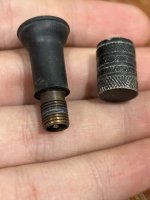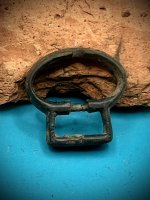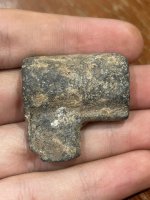Smithsgold
Hero Member
- Oct 18, 2005
- 622
- 632
- 🏆 Honorable Mentions:
- 1
- Detector(s) used
- Whites and Minelab
- Primary Interest:
- All Treasure Hunting
Exploring the Abandoned Chemung Mine
In 1900 Stephen Kavanaugh was hired to excavate a gold vein that ran along a ridge 2.5 miles southwest of Masonic.
The site overlooks Bridgeport Valley from an 8600′ Mountain perch. Stephen established the Chemung Mine in 1909, naming it after his hometown of Chemung, Illinois.
Chemung was a productive mine but overshadowed by nearby Bodie. Nevertheless, in 30 years of operation, Chemung produced over $1 million in Gold and Silver.
The ore was processed on-site, then shipped to Bodie for smelting.
Chemung consisted of a mill, mine offices, bunkhouse, and general store.
There were multiple legal issues relating to land ownership and the mine lease.
Chemung was abandoned in 1938. During the 1950s and 60’s Elton “Heinie” Heinemeyer worked the mines with no significant results.
Due to the relatively easy access to Chemung, much of the machinery has been looted. Many of the buildings and remaining machinery have been vandalized, leaving bullet holes throughout the site.
At Chemung, cyanide was used to extract gold from the ore.
Ore was crushed into a powder and added to tanks containing sodium cyanide. Lime was added to maintain a high pH, preventing the release of toxic cyanide gas. Chemung also processed ore using flotation.
Crushed ore was added to tanks containing pine and other oils. Legend says the owner of the mill fell or was pushed down a mine shaft. Some say his spirit still haunts Chemung, but in a twist, only on Saturday nights.
local legends talks about the ghosts of dead miners still dwelling these parts.
The story goes that the spirits are peaceful most of the time, except for Saturdays. Locals advise tourists, especially campers, to stay away from the mine area on Saturday nights.
Some of the locals will even tell stories about people who have entered the mine shafts on a Saturday and were never seen again.
Abandoned mines are often sealed off or grated, but not always.
They are dangerous workplaces that claimed the lives of many experienced miners and pose an enduring threat to the curious.
They cut through strata, load bearing formations, toxic mineral deposits and can house innumerable hazards from rattlesnakes to unstable explosives and radon. Unlike caves, old mines are unmaintained works of engineering designed solely for extracting ore.
They are not recreational sites. A former lode Au-Ag mine (6,200 feet) WNW of Masonic Mountain (NW slope of the mountain), on National Forest land. The Masonic Mines Association owned several claims in the area, including the Chemung Mine.
Mineralization is a vein deposit hosted in granite. Local rocks include pre-Cenozoic metasedimentary and metavolcanic rocks undivided. Workings include surface and underground openings comprised of a 200 foot deep shaft, drifts on the 50, 100 and 200 foot levels, plus some surface prospecting. A mill was erected.
Stay Out – Stay Alive !!!!
In 1900 Stephen Kavanaugh was hired to excavate a gold vein that ran along a ridge 2.5 miles southwest of Masonic.
The site overlooks Bridgeport Valley from an 8600′ Mountain perch. Stephen established the Chemung Mine in 1909, naming it after his hometown of Chemung, Illinois.
Chemung was a productive mine but overshadowed by nearby Bodie. Nevertheless, in 30 years of operation, Chemung produced over $1 million in Gold and Silver.
The ore was processed on-site, then shipped to Bodie for smelting.
Chemung consisted of a mill, mine offices, bunkhouse, and general store.
There were multiple legal issues relating to land ownership and the mine lease.
Chemung was abandoned in 1938. During the 1950s and 60’s Elton “Heinie” Heinemeyer worked the mines with no significant results.
Due to the relatively easy access to Chemung, much of the machinery has been looted. Many of the buildings and remaining machinery have been vandalized, leaving bullet holes throughout the site.
At Chemung, cyanide was used to extract gold from the ore.
Ore was crushed into a powder and added to tanks containing sodium cyanide. Lime was added to maintain a high pH, preventing the release of toxic cyanide gas. Chemung also processed ore using flotation.
Crushed ore was added to tanks containing pine and other oils. Legend says the owner of the mill fell or was pushed down a mine shaft. Some say his spirit still haunts Chemung, but in a twist, only on Saturday nights.
local legends talks about the ghosts of dead miners still dwelling these parts.
The story goes that the spirits are peaceful most of the time, except for Saturdays. Locals advise tourists, especially campers, to stay away from the mine area on Saturday nights.
Some of the locals will even tell stories about people who have entered the mine shafts on a Saturday and were never seen again.
Abandoned mines are often sealed off or grated, but not always.
They are dangerous workplaces that claimed the lives of many experienced miners and pose an enduring threat to the curious.
They cut through strata, load bearing formations, toxic mineral deposits and can house innumerable hazards from rattlesnakes to unstable explosives and radon. Unlike caves, old mines are unmaintained works of engineering designed solely for extracting ore.
They are not recreational sites. A former lode Au-Ag mine (6,200 feet) WNW of Masonic Mountain (NW slope of the mountain), on National Forest land. The Masonic Mines Association owned several claims in the area, including the Chemung Mine.
Mineralization is a vein deposit hosted in granite. Local rocks include pre-Cenozoic metasedimentary and metavolcanic rocks undivided. Workings include surface and underground openings comprised of a 200 foot deep shaft, drifts on the 50, 100 and 200 foot levels, plus some surface prospecting. A mill was erected.
Stay Out – Stay Alive !!!!





